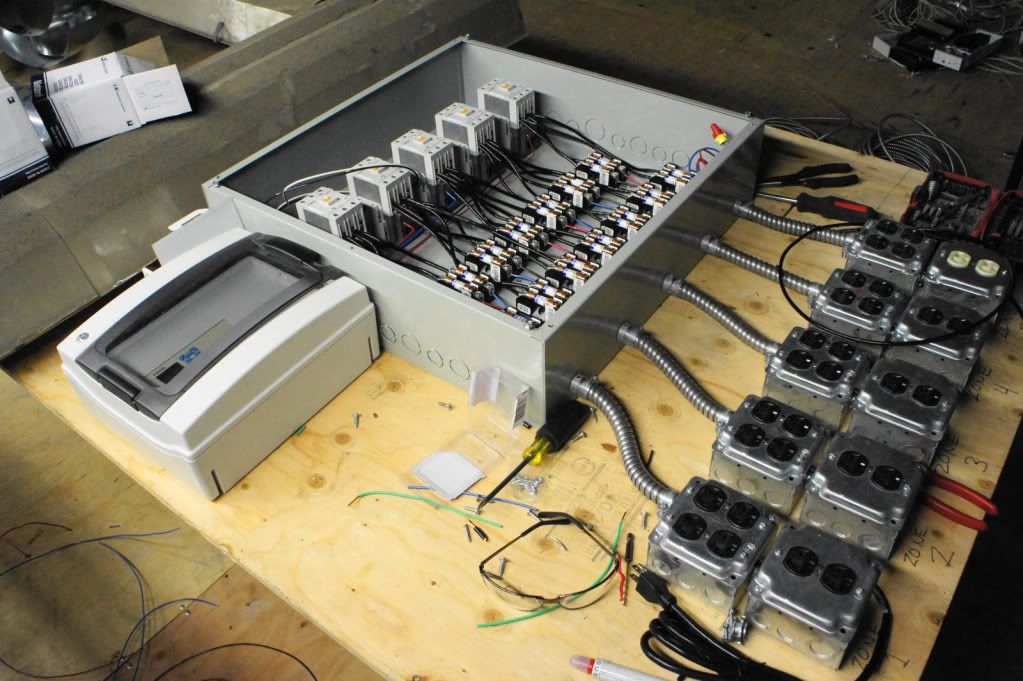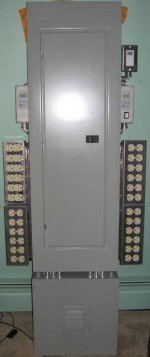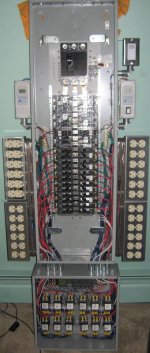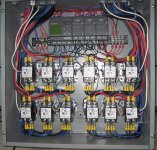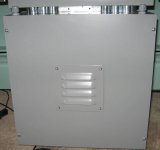You are using an out of date browser. It may not display this or other websites correctly.
You should upgrade or use an alternative browser.
You should upgrade or use an alternative browser.
Application of Nano PLC In A Growroom
- Thread starter imnotcrazy
- Start date
Three-Phase 48 Ballast Controller
Three-Phase 48 Ballast Controller
This loadcenter/controller passed inspection for a medical grow in Canada. The inspector has amazed at the detail. He told a few horror stories of CAP MLC-24s failing inspection. If you are building a MMJ grow, get a qualified electrician to build your controller, and perhaps do all the wiring.
A 48 ballast flip is being built for the same garden which will be hardwired, no Sunlight Supply receptacles and lampcords. All the cords from the lights will be hard-wired directly to the flip box.
What's really nice about the PLC, you can shut off power to the ballast(s) for a couple seconds or even a few minutes, then flip the light(s).
Three-Phase 48 Ballast Controller
This loadcenter/controller passed inspection for a medical grow in Canada. The inspector has amazed at the detail. He told a few horror stories of CAP MLC-24s failing inspection. If you are building a MMJ grow, get a qualified electrician to build your controller, and perhaps do all the wiring.
A 48 ballast flip is being built for the same garden which will be hardwired, no Sunlight Supply receptacles and lampcords. All the cords from the lights will be hard-wired directly to the flip box.
What's really nice about the PLC, you can shut off power to the ballast(s) for a couple seconds or even a few minutes, then flip the light(s).
Attachments
i want to set up a basic logic system to vent at night.
if outside temp<78 & lights=off then (trigger 2 dampers to switch from sealed to vented & Turn on exaust fan)
if outside temp >78 or lights on then (leave dampers closed and fan off)
i would imagine this would be rather simple compared to the stuff im seeing.
anyone care to give me a walkthrough or some guidance or sell me one?
if outside temp<78 & lights=off then (trigger 2 dampers to switch from sealed to vented & Turn on exaust fan)
if outside temp >78 or lights on then (leave dampers closed and fan off)
i would imagine this would be rather simple compared to the stuff im seeing.
anyone care to give me a walkthrough or some guidance or sell me one?
It was mounted 2 feet off the ground from the bottom. That was just a pic before it was installed. Those three-phase panels are almost four feet tall. I wanted to build everything inside the loadcenter, but I knew the inspector would frown. The PLC has 4 extra outputs to control the flips and possibly the AC units or anything else.
Dorje113
Member
i want to set up a basic logic system to vent at night.
if outside temp<78 & lights=off then (trigger 2 dampers to switch from sealed to vented & Turn on exaust fan)
if outside temp >78 or lights on then (leave dampers closed and fan off)
i would imagine this would be rather simple compared to the stuff im seeing.
anyone care to give me a walkthrough or some guidance or sell me one?
You might not have realized that you already wrote the program in your post, you just need to get it into the proper form for the PLC.
Just google PLC programming, decide which "language" you want to use (ladder logic or logic chart), and do it up. It might take a few hours to learn, but it's worthwhile.
You might not have realized that you already wrote the program in your post, you just need to get it into the proper form for the PLC.
Just google PLC programming, decide which "language" you want to use (ladder logic or logic chart), and do it up. It might take a few hours to learn, but it's worthwhile.
The PLC would be more fun, but all he needs is an open-on-rise (heating) thermostat with the contacts in series with a set of normally closed contacts on his lighting relay, in turn driving the fans and dampers, and he's done.
Last edited:
Dorje113
Member
The PLC would be more fun, but all he needs is an open-on-rise (heating) thermostat with the contacts in series with a set of normally closed contacts on his lighting relay, in turn driving the fans and dampers, and he's done.
lol, missed that.
KING_JOHN_C
Member
very good project
A friend and I were discussing an intelligent timer. The premise is to mimic natural conditions by creating a timer which gradually decreased the photoperiod upto and during flowering.
Ideally, you would input a lattitude and date, and some clever software would calculate the natural photoperiod for that time and location and alter it correspondingly every day.
I tend to veg my plants from 18hrs down to 14hrs in 15 minute stages before they go into the flowering room as this seems to reduce the stretch and trigger them into full flowering a little faster. Perhaps the gradual transition doesn't upset the plants circadian rhythm so much and the decreasing photoperiod sends a clear message that time to flower is approaching.
Could a PLC manage something like the above examples?
Ideally, you would input a lattitude and date, and some clever software would calculate the natural photoperiod for that time and location and alter it correspondingly every day.
I tend to veg my plants from 18hrs down to 14hrs in 15 minute stages before they go into the flowering room as this seems to reduce the stretch and trigger them into full flowering a little faster. Perhaps the gradual transition doesn't upset the plants circadian rhythm so much and the decreasing photoperiod sends a clear message that time to flower is approaching.
Could a PLC manage something like the above examples?
You could easily change the photoperiod with a PLC, but it would be easier to do it with programmed-in timers that you decremented the preset rather than try for something location and date based. For instance, you could start out with 18 hours of light and at some point start shortening the days by 15 minutes per day. Simply turn on an input to signal the math function to start.
I use an Allen Bradley micrologix 1500 PLC with RSview32 HMI software running on a PC, all the programming and HMI design I did myself so it is completely custom to my grow. The PLC controls the light power, the light flip relays, oscillating fans, inline fans, and dehumidifiers. It controls the PH and nutrient levels automatically based on the values inputted into the HMI and the feedback received from the analog probes, this values can be entered into the schedule to change week by week, it also controls the co2 Levels keeping them at 1500ppm when the lights are on. I grow RDWC and change the water every 2 weeks, this is done automatically by the plc, it shuts-off the pumps, drains the system, refills with new water, then adds nutes and phs automatically. Once a day the PC emails my blackberry with the current PH and PPM values in the system, and if any values go to far out of range it emails me a warning. I have ordered water sensors to install so that if there is a leak in one of the rooms i will get an email. All I need to do is keep the doseing containers full and the plants trimmed if i feel like it. I work with PLCs for a living and this keeps me busy, I installed automation in my grow room because i did not have the time required to take care of it all, also maybe I am a little bit lazy.
Very sweet application, BlazenCDN. I've used a number of the 1000 series with fixed I/O, but never had the opportunity to use the newer, more powerful members of the Micrologix family. It looks very well suited - you have everything well in hand without jumping to the expense of a SLC or 5.
Glad to see you start posting!
Glad to see you start posting!
Wow this is a great thread! Officially a info dense superthread.

I am building a flip box right now and was curious about digitals hot flipping.
Some camps say you can and other camps say you cant.

I am building a flip box right now and was curious about digitals hot flipping.
Some camps say you can and other camps say you cant.
I would use a PLC and wire it to the ballasts power contactor(s) and the flip relays. Shut off the ballasts for even a minute, then flip over the lights. Turn ballasts back on.
Built several flips and loadcenters linked so that the ballasts power off for each flip cycle, and since the flips are uses for veg cycles, and they lights are flipping every 1 or 2 hours during veg, it's much better to power the ballasts off, save arcing of the flip relays contacts.
Built several flips and loadcenters linked so that the ballasts power off for each flip cycle, and since the flips are uses for veg cycles, and they lights are flipping every 1 or 2 hours during veg, it's much better to power the ballasts off, save arcing of the flip relays contacts.
I could be wrong but don't digital ballast have "soft start" control built in to ramp up power when igniting? I am not sure if the ballast would stand up to the amperage surge when you flip to cold bulbs. I know someone who does flip without powering down but he uses magnetic ballasts. PLC would be the best way to do it because everything would be very accurately synchronized. If you dont have experience working with PLC's you could just use a relay. You run the power for your ballasts through a relay on normally closed contacts and use a cycle timer to power the coil for 5 minutes or whatever while you do your flip, just make sure your timers stay in sync.
I plan on buying another home in 1-2 years and when I move the grow I want to implement a plc. I have installed but never programmed logic controllers. I understand ladder logic and know I will not have any issues building the logic. Here is where I get stumped: I want a GUI that is web accessible. I think I would like to learn to custom build a GUI, as well as how to set up a secure web connection, but again I have no idea how to do this. Can anyone point me in the right direction as to where I could gain the skills for such a task? book, website, ect... recommendations. I've got the time to research.
If you use an Allen Bradley PLC like an 1100 or a 1500 micrologix, or a SLC 500 you can use a 1761-NET-ENIW for web communications, or if your using an HMI with your PLC you would be able to use a remote desktop connection. RSview does have web server applications I think it might even be called rsview web server, but a remote desktop connection is far superior. You could also do it with other software through SQL server, but that is more complicated and unnecessary for your purposes.


